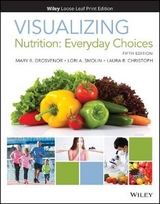
Visualizing Nutrition
John Wiley & Sons Inc (Verlag)
978-1-119-39561-4 (ISBN)
- Titel erscheint in neuer Auflage
- Artikel merken
Mary Grosvenor holds a B.A. in English and a M.S. in Nutrition Science, affording her an ideal background for nutrition writing. She is a registered dietitian and has worked in clinical and research nutrition in hospitals in communities large and small in the western United States. She has had an extensive career teaching at community colleges and has published research articles on nutritional assessment as well as nutrition and cancer. Her training and experience provide practical insights into the application and presentation of the science found in this title. Lori Smolin holds a B.S. in Nutritional Science from Cornell where she studied human nutrition and food science. She received a doctorate from the University of Wisconsin, Madison, focusing on B vitamins, homocysteine accumulation and metabolism. She completed post-doctoral training at the Harbor-UCLA Medical Center where she studied human obesity, and the University of California–San Diego where she studied genetic defects in amino acid metabolism. Dr. Smolin is currently at the University of Connecticut where she has taught both in the Department of Nutrition Science and the department of Molecular and Cell Biology.
1 Nutrition: Everyday Choices 1
1.1 Food Choices and Nutrient Intake 2
1.2 Nutrients and Their Functions 6
1.3 Nutrition in Health and Disease 9
1.4 Choosing a Healthy Diet 13
1.5 Evaluating Nutrition Information 15
2 Guidelines for a Healthy Diet 25
2.1 Nutrition Recommendations 26
2.2 Dietary Reference Intakes (DRIs) 31
2.3 The Dietary Guidelines for Americans 33
2.4 MyPlate: Putting the Guidelines into Practice 38
2.5 Food and Supplement Labels 42
3 Digestion: From Meals to Molecules 51
3.1 The Organization of Life 52
3.2 The Digestive System 55
3.3 Digestion and Absorption of Nutrients 57
3.4 The Digestive System in Health and Disease 65
3.5 Delivering Nutrients and Eliminating Wastes 73
3.6 An Overview of Metabolism 77
4 Carbohydrates: Sugars, Starches, and Fibers 82
4.1 Carbohydrates in Our Food 83
4.2 Types of Carbohydrates 85
4.3 Carbohydrate Digestion and Absorption 88
4.4 Carbohydrate Functions 92
4.5 Carbohydrates in Health and Disease 96
4.6 Meeting Carbohydrate Needs 102
5 Lipids: Fats, Phospholipids, and Sterols 113
5.1 Fats in Our Food 114
5.2 Types of Lipids 115
5.3 Absorbing and Transporting Lipids 121
5.4 Lipid Functions 125
5.5 Lipids in Health and Disease 128
5.6 Meeting Lipid Needs 133
6 Proteins and Amino Acids 143
6.1 Proteins in Our Food 144
6.2 The Structure of Amino Acids and Proteins 145
6.3 Protein Digestion and Absorption 147
6.4 Protein Synthesis and Functions 149
6.5 Protein in Health and Disease 153
6.6 Meeting Protein Needs 157
6.7 Vegetarian Diets 163
7 Vitamins 170
7.1 A Vitamin Primer 171
7.2 Vitamins and Energy Metabolism 179
7.3 Vitamins and Healthy Blood 186
7.4 Antioxidant Vitamins 196
7.5 Vitamins in Gene Expression 200
7.6 Meeting Needs with Dietary Supplements 211
8 Water and Minerals 219
8.1 Water 220
8.2 An Overview of Minerals 226
8.3 Electrolytes: Sodium, Potassium, and Chloride 232
8.4 Minerals and Bone Health 240
8.5 Minerals and Healthy Blood 249
8.6 Antioxidant Minerals 253
8.7 Minerals and Energy Metabolism 257
9 Energy Balance and Weight Management 265
9.1 Body Weight and Health 266
9.2 Energy Balance 273
9.3 What Determines Body Size and Shape? 278
9.4 Managing Body Weight 283
9.5 Medications and Surgery for Weight Loss 290
9.6 Eating Disorders 293
10 Nutrition, Fitness, and Physical Activity 304
10.1 Food, Physical Activity, and Health 305
10.2 The Four Components of Fitness 307
10.3 Physical Activity Recommendations 309
10.4 Fueling Activity 313
10.5 Energy and Nutrient Needs for Physical Activity 319
10.6 Food and Drink to Optimize Performance 325
10.7 Ergogenic Aids 329
11 Nutrition during Pregnancy and Infancy 339
11.1 Changes in the Body during Pregnancy 340
11.2 Nutritional Needs during Pregnancy 345
11.3 Factors That Increase the Risks Associated with Pregnancy 351
11.4 Lactation 356
11.5 Nutrition for Infants 359
12 Nutrition from 1 to 100 371
12.1 The Nutritional Health of America’s Youth 372
12.2 Nutrition for Children 376
12.3 Nutrition for Adolescents 383
12.4 Nutrition for the Adult Years 388
12.5 The Impact of Alcohol Throughout Life 397
13 How Safe Is Our Food Supply? 405
13.1 Keeping Food Safe 406
13.2 Pathogens in Food 410
13.3 Preventing Microbial Food-Borne Illness 417
13.4 Agricultural and Industrial Chemicals in Food 421
13.5 Technology for Keeping Food Safe 427
13.6 Biotechnology 432
14 Feeding the World 440
14.1 The Two Faces of Malnutrition 441
14.2 Causes of Hunger around the World 443
14.3 Causes of Hunger in the United States 448
14.4 Eliminating World Hunger 450
14.5 Eliminating Food Insecurity in the United States 457
APPENDIX A Dietary Reference Intakes A-1
ONLINE APPENDICES
APPENDIX A Dietary Reference Intakes
APPENDIX B Healthy Eating Patterns
APPENDIX C U.S. Nutrition Guidelines and Recommendations
APPENDIX D Energy Expenditure for Various Activities
APPENDIX E Standards for Body Size
APPENDIX F Normal Physiological Standards of Nutritional Relevance
APPENDIX G Choice (Exchange) Lists
APPENDIX H Food and Supplement Labels
APPENDIX I World Health Organization Nutrition Recommendations
APPENDIX J Calculations and Conversions
APPENDIX K Popular Dietary Supplements
APPENDIX L Answers to thinking it through
GLOSSARY GL-1
REFERENCES R-1
INDEX I-1
| Erscheinungsdatum | 25.11.2021 |
|---|---|
| Verlagsort | New York |
| Sprache | englisch |
| Maße | 211 x 272 mm |
| Gewicht | 930 g |
| Themenwelt | Sachbuch/Ratgeber ► Gesundheit / Leben / Psychologie ► Ernährung / Diät / Fasten |
| Medizin / Pharmazie ► Allgemeines / Lexika | |
| Medizin / Pharmazie ► Gesundheitsfachberufe ► Diätassistenz / Ernährungsberatung | |
| ISBN-10 | 1-119-39561-5 / 1119395615 |
| ISBN-13 | 978-1-119-39561-4 / 9781119395614 |
| Zustand | Neuware |
| Informationen gemäß Produktsicherheitsverordnung (GPSR) | |
| Haben Sie eine Frage zum Produkt? |
